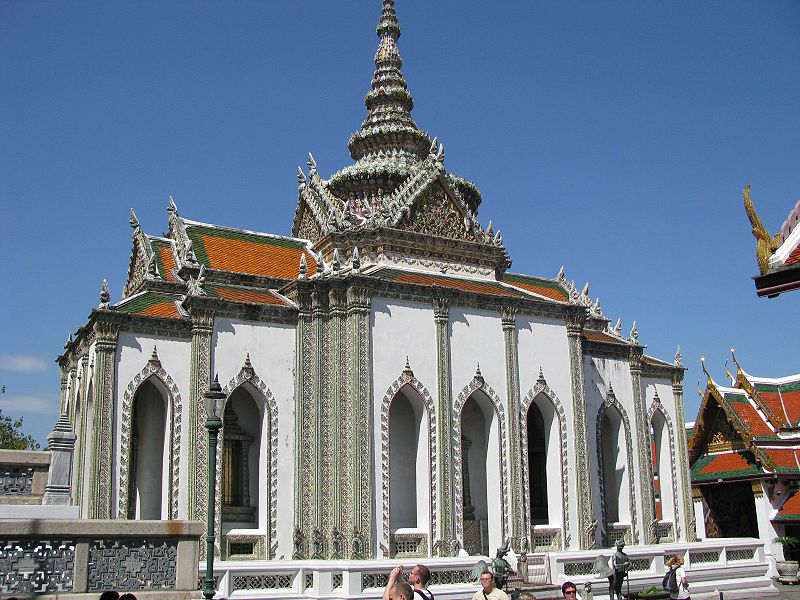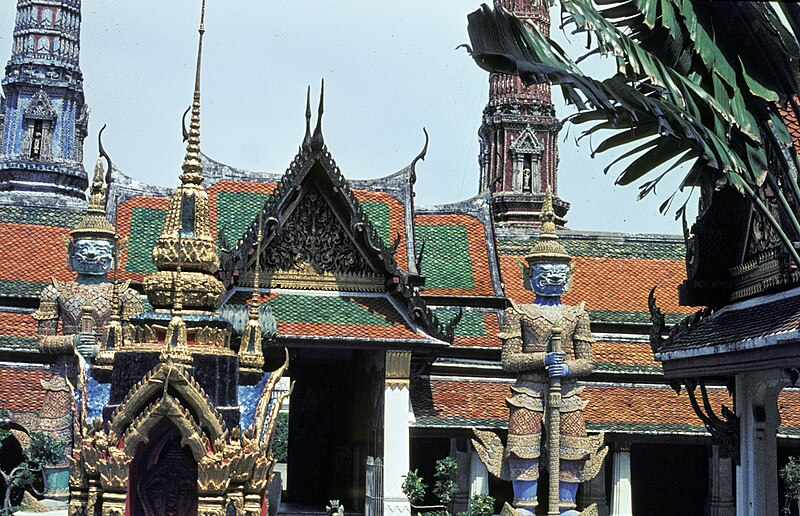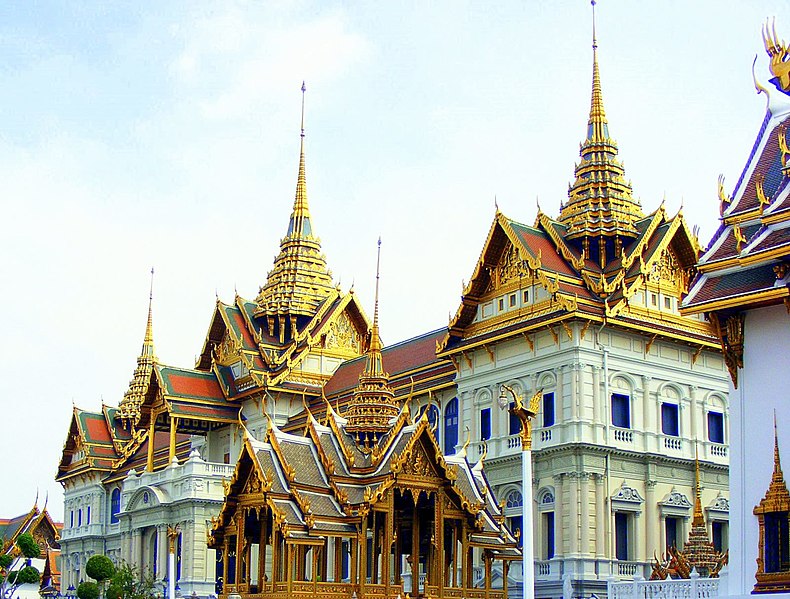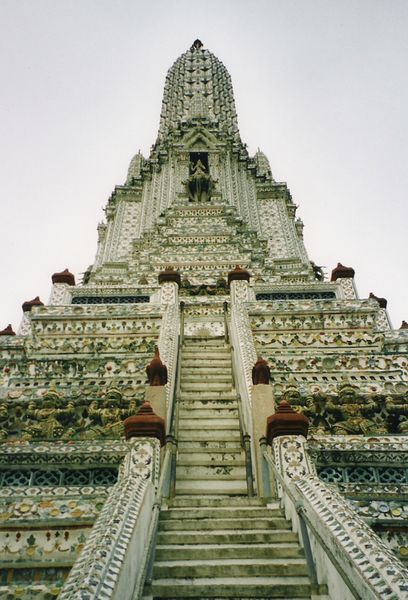The Wat Phra Kaew (Thai: วัดพระแก้ว, RTGS: Wat Phra Kaeo, English: Temple of the Emerald Buddha; full official name Wat Phra Si Rattana Satsadaram, Thai: วัดพระศรีรัตนศาสดาราม) is regarded as the most sacred Buddhist temple (wat) in Thailand. It is a "potent religio-political symbol and the palladium of Thai society". It is located in the historic centre of Bangkok (district Phra Nakhon), within the precincts of the Grand Palace.
 The main building is the central ubosoth, which houses the statue of Emerald Buddha. The legendary history of this Buddha image is traced to India, five centuries after the Lord Buddha attained Nirvana, till it was finally enshrined in Bangkok at the Wat Phra Kaew temple in 1782 during Rama I's reign (1782–1809). This marked the beginning and raise of the Chakri Dynasty of the present Kingdom of Thailand (the present head of the dynasty is King Rama IX. The Emerald Buddha, a dark green statue, is in a standing form, about 66 centimetres (26 in) tall, carved from a single jade stone (Emerald in Thai means deep green colour and not the specific stone). It is carved in the meditating posture in the style of the Lanna school of the northern Thailand. Except for the Thai King, no other person is allowed to touch the statue. The King changes the cloak around the statue three times a year, corresponding to the summer, winter, and rainy seasons, an important ritual performed to usher good fortune to the country during each season.
The main building is the central ubosoth, which houses the statue of Emerald Buddha. The legendary history of this Buddha image is traced to India, five centuries after the Lord Buddha attained Nirvana, till it was finally enshrined in Bangkok at the Wat Phra Kaew temple in 1782 during Rama I's reign (1782–1809). This marked the beginning and raise of the Chakri Dynasty of the present Kingdom of Thailand (the present head of the dynasty is King Rama IX. The Emerald Buddha, a dark green statue, is in a standing form, about 66 centimetres (26 in) tall, carved from a single jade stone (Emerald in Thai means deep green colour and not the specific stone). It is carved in the meditating posture in the style of the Lanna school of the northern Thailand. Except for the Thai King, no other person is allowed to touch the statue. The King changes the cloak around the statue three times a year, corresponding to the summer, winter, and rainy seasons, an important ritual performed to usher good fortune to the country during each season.While legend traces this statue to India, its rich historical records dates its finding in Cambodia in the 15th century, moved to Laos in the 16th century and then to Vientiane where it remained for 215 years, and finally to Thailand in the 18th century. Considering the long history and Nagasena's (a Brahmin who became a Buddhist sage and lived about 150 BC) prophesy that the Emerald Buddha would bring "prosperity and pre-eminence to each country in which it resides", the Emerald Buddha deified in the Wat Phra Kaew is deeply revered and venerated in Thailand as the protector of the country.
The earliest legend narrated to the ionic emerald image of the Buddha is that of Nagasena, a saint in India who with the help of Hindu god, Vishnu and demigod Indra got the Emerald Buddha image made, 500 years after Buddha attained Nirvana, from the precious stone of Emerald. Nagasena had, with his psychic powers predicted then that:
The image of the Buddha is assuredly going to give to religion the most brilliant importance in five lands, that is in Lankadvipa (Sri Lanka), Ramalakka, Dvaravati, Chieng Mai and Lan Chang (Laos).
As regards the historical legend of What Phra Kaew, it was originally known as the "Wat Pa Yia", (Bamboo Forest Monastery) in the Chiang Rai province of Northern Thailand. The What was struck by a lightning storm in 1434, when the octagonal Chedi broke up and revealed the Emerald Buddha (made of Jade), locally known as Phra Kaew Morakot. From there it was moved, initially to Vientianne and finally to Bangkok where it was deified in the temple by the original name, What Phra Kaew.
Another legend mentions that attempts made by the King of Chiang Mai to possess the statue after it was found in 1434; these failed thrice because the elephants transporting the statue refused to proceed beyond a crossroad in Lampang. The King of Chiang Mai considered the incident to be a strong divine directive and allowed the Buddha statue to remain in Lampang, where it remained for the next 32 years in an exclusively built temple.
Wat Phra Kaeo has a plethora of buildings within the precincts of the Grand Palace, which covers a total area of over 94.5 hectares (234 acres). It has over 100 buildings with “200 years royal history and architectural experimentation” linked to it. The architectural style is named as Rattanakosin style (old Bangkok style). The main temple of the Emerald Buddha is very elegantly decorated and similar to the temple in ancient capital of Ayudhya. The roof is embellished with polished orange and green tiles, the pillars are inlaid in mosaic and the pediments are made of rich marble. The Emerald Buddha is deified over an elevated altar surrounded by large gilded decorations. While the upper part of this altar was part of the original construction, the base was added by King Rama III. Two images of the Buddha, which represent the first two kings of the Chakri dynasty, flank the main image.
Over the years, the temple has retained its original design. However, minor improvements have been effected after its first erection during Rama I's reign; wood-work of the temple was replaced by King Rama III and King Chulalongkorn; during King Mongkut's reign, the elegant doors and windows and the copper plates on the floor were additions, Rama III refurbished the wall painting (indicative of the universe according to Buddhist cosmology) and several frescoes that display the various stages of the Buddha's life; three chambers were added on the western side by King Mongkut; in the chamber known as 'Phra Kromanusorn' at the northern end, images of Buddha have been installed in honour of the kings of Ayudya; and in the 19th century, In Khong, a famous painter executed the wall murals. The entry to the temple is from the third gate from the river pier.
Other monuments
While the surrounding portico of the shrine is an example of Thai craftsmanship, the perimeter of the temple complex has 12 open pavilions. These were built during the reign of Rama I. There is plethora of monuments in the temple complex. These are:
Grand Palace: Please see detail in next post.
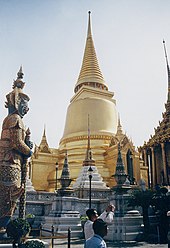 Pagodas: The temple grounds also depict three pagodas to its immediate north, which represent the changing centres of Buddhist influence. One such shrine to the west of the temple is the Phra Si Ratana Chedi, a 19th-century stupa built in Sri Lankan style enshrining ashes of the Buddha.
Pagodas: The temple grounds also depict three pagodas to its immediate north, which represent the changing centres of Buddhist influence. One such shrine to the west of the temple is the Phra Si Ratana Chedi, a 19th-century stupa built in Sri Lankan style enshrining ashes of the Buddha.Library: Rama I also built a library in Thai style, in the middle of the complex, known as the "Phra Mondop". The library houses an elegantly carved Ayutthaya-style mother-of-pearl doors, bookcases with the Tripitaka (sacred Buddhist manuscripts), human-and dragon-headed nagas (snakes), and images of Chakri kings.
During the 19th century, the Royal Pantheon was built in Khmer style to the east of the temple, which is kept open for only one day in year, in the month of October to commemorate the founding of the Chakri dynasty.
Model of Angkor Wat: The temple complex also contains a model of Angkor Wat (the most sacred of all Cambodian shrines), that was started by King Mongkut and completed by King Nangklao (Rama III), as the Khmer empire of Cambodia and the Thais' share cultural and religious roots.
 Hermit statue: A hermit's bronze image, which is believed to have healing powers, is installed in a sala on the western side of the temple. It is near the entry gate. It is a black stone statue, considered a patron of medicine, before which relatives of the sick and infirm pay respects and make offerings of joss sticks, fruit, flowers, and candles.
Hermit statue: A hermit's bronze image, which is believed to have healing powers, is installed in a sala on the western side of the temple. It is near the entry gate. It is a black stone statue, considered a patron of medicine, before which relatives of the sick and infirm pay respects and make offerings of joss sticks, fruit, flowers, and candles.Nine towers: On the eastern side of the temple premises there are nine towers. They were erected during the reign of Rama I. Each tower is affixed with glazed tiles, with different colours for each tower, supposed to denote colours of the nine planets.
Elephant statues: Statues of elephants, which symbolize independence and power, are seen all around the complex. As Thai kings fought wars mounted on elephants, it has become customary for parents to make their children circumambulate the elephant three times with the belief that that it would bring them strength. The head of an elephant statue is also rubbed for good luck; this act of the people is reflected in the smoothness of the surface of elephant statues here.
The sacred temples in Thailand follow a dress code, which is strictly followed. Men must wear long pants and long-sleeved shirts and shoes; women must wear long skirts. Visitors who arrive dressed otherwise may rent appropriate clothing items at the entry area of the temple. It is compulsory to remove the shoes before entering the temple, as a sign of respect of the Buddha, as is the practice in all other temples in Thailand. While offering prayers before the Buddha image, the sitting posture should avoid any offensive stretching of feet towards the deity; the feet should be tucked in towards the back.
Source: http://en.wikipedia.org/wiki/Wat_Phra_Kaew
Images: http://commons.wikimedia.org/wiki/Category:Wat_Phra_Kaew






